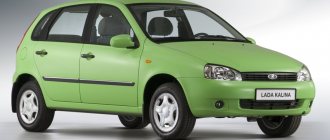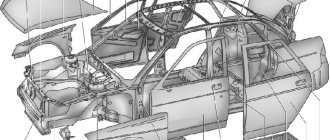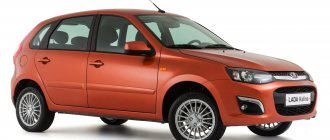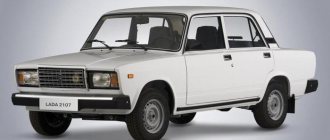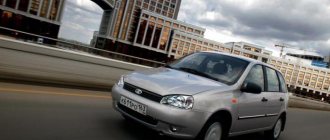The production of the restyled LADA Priora (“Lada Priora”) began in November 2013. The following cars of this family roll off the assembly line of JSC AVTOVAZ: VAZ-2170 - with a sedan body, VAZ-2171 - with a station wagon body, VAZ-2172 - with a body hatchback (five-door and three-door). The cars can be equipped with two four-cylinder sixteen-valve engines with a volume of 1596 cm3 and a power of 98 and 106 hp. Toxicity standards comply with Euro-4 standard. The cars are equipped with a five-speed manual transmission with front-wheel drive.
The updated LADA Priora meets modern requirements for passive safety. The front and rear bumpers are made of impact-resistant material to absorb impact energy during a collision. The B-pillars, roof and sills are reinforced. Metal reinforcements are installed in all doors to improve resistance to side impacts.
The information is relevant for Priora models 2013, 2014, 2015, 2016, 2017, 2022 model years.
The basic equipment of the car includes: a tilt-adjustable steering column, power windows for the front doors, a driver's airbag, and electrically adjustable exterior mirrors. The car's headlights can operate as daytime running lights, which do not blind drivers in the oncoming lane and significantly reduce energy consumption.
To better meet customer needs, the vehicle is equipped with various options. These include: front passenger airbag, front seat belt pretensioners, anti-lock brakes (ABS), electronic stability control (ESC), cruise control, air conditioning, power windows on all doors, power mirrors, modern multimedia system, on-board computer , automatic windshield wiper control, automatic exterior lighting control, turn signals in the side mirrors, fog lights, heated windshield.
LADA Priora is a compact, economical car, well adapted to the conditions of our climate and the characteristics of Russian roads.
The dimensions of the restyled Lada Priora have not changed significantly. Although, due to the new front and rear bumpers, the length of the Lada Priora has changed by several millimeters.
As before, the restyled Lada Priora sedan has the longest length, which in the new version is 4,350 mm. The length of the station wagon is 1 centimeter shorter, but the Priora hatchback is even smaller, the length of this version of the body is 4210 mm. The width of the entire family is 1,680 mm and the wheelbase is the same for all 2,492 mm. But everyone’s height is different, the Lada Priora sedan is 1,420 mm, the hatchback is 1,435 mm, but the station wagon is generally 1,508 mm in height. The high height of the Priora station wagon is explained by the presence of roof rails. In a hatchback, the design of the rear part of the body is such that the car turns out to be taller than a sedan.
As for the ground clearance or ground clearance of the Lada Priora , the manufacturer indicates a figure of 165 mm for the sedan and hatchback, while the ground clearance for the Lada Priora station wagon is 170 mm . However, in fact, the ground clearance is greater; just pick up a tape measure and make sure of this. But the manufacturer is not mistaken; he simply indicates the vehicle’s ground clearance when fully loaded. At the same time, manufacturers of foreign cars are cunning and indicate the ground clearance of their cars in an unloaded state. therefore, the real ground clearance of foreign cars and their official data often do not coincide.
The luggage compartment volumes of the new version of Lada Priora in all three bodies have changed little. The sedan's trunk volume is 430 liters. The luggage compartment volume of the Priora hatchback is smaller, only 306 liters, but if you fold the rear seats (which cannot be done in a sedan), the volume increases to 705 liters. In the Priora station wagon, the luggage compartment volume is 444 liters, and with the seats folded down it reaches 777 liters. Unfortunately, the rear seats do not fold flat with the floor, and the large wheel arches eat up quite a lot of luggage space.
Further detailed data on the dimensions of the Lada Priora are in the table below.
Dimensions of Lada Priora
| sedan | hatchback | station wagon | |
| Length, mm | 4350 | 4210 | 4340 |
| Width | 1680 | 1680 | 1680 |
| Height | 1420 | 1435 | 1508 |
| Front wheel track | 1410 | 1410 | 1414 |
| Rear wheel track | 1380 | 1380 | 1380 |
| Wheelbase | 2492 | 2492 | 2492 |
| Trunk volume, l | 430 | 360 | 444 |
| Volume with seats folded | – | 705 | 777 |
| Fuel tank volume | 43 | 43 | 43 |
| Ground clearance, mm | 165 | 165 | 170 |
As for the Lada Priora tire size , the manufacturer recommends installing 14-inch wheels. The tire size can be 175/65 R14 or 185/60 R14 or 185/65 R14. The most interesting thing is that today, even on Lada Granta or Kalina in well-packaged trim levels, AvtoVAZ offers 15-inch wheels as standard. Why this is not the case on Priora is not clear, although this does not stop the owners of these cars, who put much larger wheels on their Lada Priora.
Main characteristics
| Brand | VAZ |
| Model | Lada Priora Hatchback |
| Modification | Lada Priora Hatchback 1.6 MT 98 hp |
| Model year | 2013 |
| Body type | Hatchback |
| Number of doors | 5 |
| Number of seats | 5 |
| Country of assembly | Russia |
Performance characteristics
| Type of fuel | AI-95 |
| Acceleration time to 100 km/h | 11.5 sec |
| Maximum speed | 183 km/h |
| Fuel consumption in the urban cycle | 9.1 l per 100 km |
| Fuel consumption on the highway | 5.5 l per 100 km |
| Combined fuel consumption | 6.9 l per 100 km |
| Power reserve | 473 – 782 km |
| Fuel costs per year (with a mileage of 100 km per day) | 119 629₽ |
| Transport tax * (Moscow) | 1 176₽ |
| OSAGO * (Moscow, age over 22 years, experience over 3 years) | 7 570₽ |
* Use Tax and OSAGO calculators for more detailed calculations.
Dimensions and dimensions
| Length | 4210 mm |
| Width | 1680 mm |
| Height | 1435 mm |
| Ground clearance | 165 mm |
| Front track | 1410 mm |
| Rear track | 1380 mm |
| Wheelbase | 2492 mm |
| Turning diameter | 11.6 m |
Weight
| Curb weight | 1163 kg |
| Full mass | 1578 kg |
| Load capacity | 415 kg |
Volumes
| Trunk volume | 360 l |
| Fuel tank volume | 43 l |
Engine
| engine's type | Petrol |
| Number of cylinders / arrangement | 4/Inline |
| Engine power, hp/rpm | 98/5600 |
| Engine displacement | 1596 cm³ |
| Torque, Nm/rpm | 145/4000 |
Transmission
| Drive unit | Front |
| Gearbox type | Mechanical, 5 gears |
Body
Transmission
Initially, the hatchback came with a manual transmission. In fact, it was a strengthened version of the gearbox from the 110th Lada. Drivers immediately noted the poor quality of the mechanics, which became known for having very poor synchronizers. Often the handle simply “jumped” out of gear or the desired mode simply did not turn on.
The release lever began to knock just 3 months after purchase, and unclear shifts were observed immediately from the passenger compartment.
Subsequently, the restyled version of “2180” received updated mechanics, which worked much smoother. The sudden knocks disappeared and shifts became smooth. Afterwards, AvtoVAZ updated the gearbox and installed a robotic version, which received mixed reviews. However, it is very reliable and convenient; there are no reviews about its inoperability.
Modifications of Lada Priora
Lada Priora 1.6 AMT
| Maximum speed, km/h | 183 |
| Acceleration time to 100 km/h, sec | 11.4 |
| Engine | Petrol |
| Working volume, cm3 | 1596 |
| Power, hp / rpm | 106/5800 |
| Torque, Nm/rpm | 148/4200 |
| Combi consumption, l per 100 km | 6.6 |
| Gearbox type | Robotic, 5 gears |
| Drive unit | Front |
Lada Priora 1.6 MT
| Maximum speed, km/h | 176 |
| Acceleration time to 100 km/h, sec | 12.5 |
| Engine | Petrol |
| Working volume, cm3 | 1596 |
| Power, hp / rpm | 87/5100 |
| Torque, Nm/rpm | 140/3800 |
| Combi consumption, l per 100 km | 7.0 |
| Gearbox type | Mechanical, 5 gears |
| Drive unit | Front |
Lada Priora 1.6 MT 106 hp
| Maximum speed, km/h | 183 |
| Acceleration time to 100 km/h, sec | 11.5 |
| Engine | Petrol |
| Working volume, cm3 | 1596 |
| Power, hp / rpm | 106/5800 |
| Torque, Nm/rpm | 148/4200 |
| Combi consumption, l per 100 km | 6.9 |
| Gearbox type | Mechanical, 5 gears |
| Drive unit | Front |
Lada Priora 1.6 MT 98 hp
| Maximum speed, km/h | 183 |
| Acceleration time to 100 km/h, sec | 11.5 |
| Engine | Petrol |
| Working volume, cm3 | 1596 |
| Power, hp / rpm | 98/5600 |
| Torque, Nm/rpm | 145/4000 |
| Combi consumption, l per 100 km | 6.9 |
| Gearbox type | Mechanical, 5 gears |
| Drive unit | Front |
Performance characteristics of the Priora car engine: 126 and 127, how many horsepower and torque
The technical characteristics of the Priora car engine show 98 and 106 horsepower on board. This applies to engines with a displacement of 1.6 liters.
- Motor - 98 horsepower received number 21126. Maximum torque - 4000 rpm at 145 Nm.
- Motor - 106 horsepower is listed under number 21127, torque - 4,200 rpm at 148 km.
Motor 21127 is a modified version of the 126 model, but both of them are available with sixteen valves. In addition, the Priora has two eight-valve engines with a displacement of 1.6 liters, which produce 81 and 87 hp, but they are not as common as newer versions. Interestingly, there are engines with a volume of 1.8 liters.
- The first 1.8 liter engine produces 98 hp. (21127 also works), but the torque is 3000 rpm at 160 Nm.
- The 123 hp engine, which was installed on sports versions, produces 4000 rpm at 165 Nm.
Compared to the weight of the car, sixteen-valve engines are sufficient for free movement.
As for the technical condition, the VAZ-21126 and subsequent models are superior to eight-valve versions of engines, which is why car owners choose them more often. The most common “layout” is the Priora sedan with a 21126 engine and a manual transmission.
Technical characteristics of Lada Priora station wagon
The dimensions of the Priora station wagon, after restyling, have changed slightly due to new bumpers. So previously the length of the car was 4,330 mm, now it is 4,340 mm. It is also worth noting that the ground clearance of the Lada Priora station wagon is 5 mm greater than that of the sedan and hatchback and is equal to 170 mm. This difference is explained by the reinforced suspension, since the station wagon is designed not only for transporting passengers, but also for transporting all kinds of cargo. In particular, the car's rear springs have more coils. The height of the car is also greater when compared with its siblings. There is no big secret here, it’s just that all Lada Priora station wagons come standard with roof rails. See the detailed overall dimensions of the Priora station wagon below.
Dimensions, ground clearance, trunk Lada Priora station wagon
- Length – 4340 mm
- Width – 1680 mm
- Height – 1508 mm
- Curb weight/gross weight – 1185 / 1593 kg
- Front/rear wheel track – 1410 / 1380 mm
- Base, distance between front and rear axle – 2492 mm
- Trunk volume – 444 liters
- Trunk volume with seats folded – 777 liters
- Fuel tank volume – 43 liters
- Tire size – 175/65 R14 or 185/60 R14 or 185/65 R14
- Ground clearance of the Lada Priora station wagon – 170 mm
As for the power units, here, as in the case of the hatchback and sedan, there are two engines to choose from, this is the VAZ-21126 engine with a power of 98 hp. and a more advanced modification with passive supercharging VAZ-21127 with a power of 106 hp. However, unofficially the VAZ-21127 engine produces a little more horses. Both engines have 4 cylinders and 16 valves, two camshafts driven by a belt. Below are the parameters of these motors.
Characteristics of the VAZ-21126 16 class engine. Manual transmission 5-speed
- Working volume – 1596 cm3
- Power hp/kW – 98/72 at 5600 rpm
- Torque – 145 Nm at 4000 rpm
- Fuel consumption in the combined cycle – 6.9 liters
Characteristics of the VAZ-21127 16 cl. Manual transmission 5-speed
- Working volume – 1596 cm3
- Number of cylinders/valves – 4/16
- Power hp/kW – 106/78 at 5800 rpm
- Torque – 148 Nm at 4200 rpm
- Maximum speed – 183 kilometers per hour
- Acceleration to the first hundred – 11.5 seconds
- Fuel consumption in the combined cycle – 6.8 liters
Catalog number and cost of the standard Priora fuel tank
The official article number for the Priora fuel tank is: 21082110101370. Its cost is 3.5-5.5 thousand Russian. rub. In addition, now you can easily purchase a used gas tank for our car in excellent condition. The price for such a tank varies between 1-2 thousand Russian. rub. You can also take into account that the Priora’s tank is exactly the same as that of the “eight” and “ten”, with the same volume. If you need to find out about the traffic police, fines, traffic rules and car insurance, visit https://progai.info/.
Body dimensions and weight of the Lada Priora car - hatchback, station wagon, sedan, coupe, long
The ideal car is different for everyone - it all depends on why they are buying it. Priora is perfect for both the younger generation and the older. The weight that it can lift varies - for example, the station wagon received a voluminous trunk that can accommodate more things. The width of the Priora remains unchanged - exactly 164 cm. The weight of the car ranges from 1578 to 1598 kg.
Hatchback
When it comes to overall dimensions, the Lada Priora cannot but rejoice - you can drive with it even in the narrowest yard. The curb weight of the hatchback is 1163 kg, the maximum permissible is 1578 kg. The trunk volume is 360 liters, and with the seats folded down – 705 liters. Height is 143.5 cm, length – 421 cm.
Sedan
The dimensions of the sedan are slightly different, but the weight of the car remains the same. The trunk volume is 430 liters. The sedan body dimensions are 142 cm in height, length is 435 cm.
Station wagon
The improved technical characteristics of the Lada Priora station wagon allow you to seriously load the trunk - they took care of the reinforced suspension in advance. Unlike the hatchback, the station wagon has a length of 13 cm longer - 434 cm. The height is 150.8 cm. The trunk volume is 444 liters and 777 liters with the seats folded down. The total weight can be equal to 1598 kg.
Coupe
The three-door hatchback Lada Priora was produced in a sports version and featured improved characteristics - after restyling, there were 123 horses under its hood. The body elements had to be redone, which did not affect the dimensions so much. Length is 424.3 cm, height 143.5 cm.
Long body
The extended Priora is the Premier version, premium. Its base was lengthened by 17.5 cm, the rear door was made larger, and an additional section was added to the glass. Under the hood there is a noticeable advantage - more “horses” are needed to pull a heavier car. The salon is decorated elegantly and stylishly. The width remains the same - 168 cm, the length is 452.5 cm, and the height is 142 cm. The curb weight is 1100 kg, and the trunk volume remains the same - 430 liters.
Add a comment Cancel reply
You must be logged in to post a comment.
From this article you will learn the dimensions of the Lada body and its features. Our domestic designers have finally managed to carry out high-quality body engineering that meets international standards. Finally, the torsional rigidity (TR) of the bodies of Lada Largus, Kalina, etc. and other features, to the envy of previous VAZ models, have become much higher. This means that now domestic models can easily compete with foreign cars in terms of body endurance.
Restyling Lada Priora 2013
The 2013 restyling consisted of some changes regarding the appearance, some equipment, interior and engine. Among such changes in Prior we will name:
- A slightly modified exterior geometry, which, however, makes no sense to describe, since visually Priora before and after restyling remained almost indistinguishable in appearance;
- Replacing the radiator grille with an elongated “honeycomb”, slightly tilting the car into the now fashionable “organic” style, characterized by biological forms;
- Improved external lighting technology, thanks to which the car’s dimensions have become clearer in the dark. In particular, the area of the reflectors has been increased, LED sections for side lights and brake lights have been added, which are both brighter and more responsive when switched on;
- A dashboard that is implemented differently: instead of four “dials,” the sensor arrows were arranged in two, without compromising functionality. Purely aesthetically it looks better, but from an ergonomic point of view, a lot depends on habit;
- An increased number of pictograms flashing on the dashboard, making it easier to figure out which lighting equipment is faulty;
- An added niche in the center of the dashboard, in which the on-board computer is placed;
- Extended front seat slides, allowing tall drivers and front passengers to adjust their seat positions more flexibly;
- A box that is more spacious in depth to the right of the driver;
- A more attractive three-spoke steering wheel with an airbag under a triangular cover;
- In the “luxury” configuration – leather upholstery based on a combination of auto fabric and eco-leather;
- New door card design.
Also, since 2013, Priors have been produced in a different engine configuration, from which the 80-horsepower engine was removed, but a new 106 l/s engine was added, which, like everyone else, reaches speeds of up to 183 km/h and reduces fuel consumption to 6. 8 – 6.9 liters per hundred km. This engine is equipped with the “luxury” configurations of the Priora. Of course, such a reduction in fuel consumption is very attractive to the consumer. We can only hope that the developers will continue to work in this direction. In addition, the new engine fits well into Euro-3 and Euro-4 environmental standards, thanks to the closely located catalyst. Due to rapid heating, the catalysis of toxic substances occurs more vigorously, as a result of which a lower concentration of them enters the atmosphere.
The restyled Prior also has a drawback (compared to previous editions of this car): the carpet in the trunk is thinner than its predecessors, which is why the noise level while driving is higher. Motorists are advised to take care of additional sound insulation in the trunk. In addition, the curb weight of the car has increased (to 1185 kg), which is by as much as 100 kg. reduced its cargo capabilities, since the maximum weight remained the same - 1593 kg. for a station wagon, and 1578 kg. for other body variations.
Suspension characteristics
The Priora's chassis was designed for smooth driving over bumps and obstacles, as well as driving along a country road. Of course, the VAZ-2170 is not an SUV, but it can easily go through many places. The front part of the suspension is independent, and the rear part is semi-independent, which makes the car softer.
Many owners almost immediately replace the anti-roll bar arms along with the struts with a sports kit - so that the car does not wobble when making a sharp turn. Telescopic shock absorbers consistently dampen vibrations when passing obstacles, so there will be no problems with it. VAZ-2170 is a front-wheel drive car.
- Front suspension is MacPherson type with longitudinal braces.
- The rear suspension is also with trailing arms. It has a U-shaped transverse beam, to which a torsion-type anti-roll bar is attached.
As for the ground clearance, for the pre-restyling version it was 165 mm, and for the restyled version it was 170 mm. The wheelbase is 249.2 cm, the front track width is 141 cm, the rear track is 138 cm. The suspension can be lowered or raised if desired - ready-made kits for modernization are available for open sale.
Brake system
The front and rear brakes are different. There are ventilated disc brakes with a single-piston floating caliper and automatic adjustment of the gap between the pads and the disc at the front, and drum brakes at the rear. The brake system is diagonal, dual-circuit, hydraulic. Equipped with a vacuum booster.
It is possible to work with the traction control system. You can also install disc brakes at the rear instead of standard drum brakes. The new braking system will also support ABS. The parking brake is manual, on a cable with drive of the rear wheels.
Versions of the Priora station wagon
For the Lada Priora station wagon, three configuration options are possible:
- “Standard” is the cheapest (not produced since 2014).
- “Norma”, which includes an airbag for the driver, a brake system with a vacuum booster, front disc brakes, power steering, inertia seat belts, an anti-theft alarm, running lights for daylight hours, a fabric interior, and electric heated exterior mirrors.
- The “Lada Priora” station wagon “Lux” is distinguished by the fact that it has airbags for passenger seats in the first row, a rain sensor, electric windows in the rear doors, and alloy wheels. The interior finishing material is Alcantara (artificial suede). The front seats can be adjusted. In some cases, the Lada Priora Lux station wagon is equipped with parking sensors and a navigator.
In 2013, the car was restyled. Externally, the 2013 station wagon and the 2014 station wagon differ little. The new version features an updated radiator grille, side collars on the side mirrors, the front and rear bumpers have changed, and LEDs have been installed in the headlights.
The interior of the 2013 Priora station wagon has undergone major changes. It was modernized with the participation of the Italian design studio Carcerano. The car is now equipped with a three-spoke steering wheel, and a color monitor is installed in the center console to control the stereo system and display navigator information. In older trim levels, the front row seats are equipped with additional airbags and adjustable heating.
Vehicle body and layout
Body type VAZ 2171 is a five-seater, five-door station wagon. The fifth door is solid and opens upward. The overall dimensions of the Lada Priora station wagon (body length, width and height) are 4210, 1680 and 1420 mm, respectively. The height is indicated taking into account the roof rails, which are not removable. For the Lada Priora station wagon, 10 body color options are offered: from black and dark red to white and silver. The "Lada Priora" station wagon in "Snow Queen" color is most suitable for southern regions, since it heats up less from the sun. In summer, cars of this color will not be so hot.
The vehicle's wheelbase (the distance between the front and rear axles) is 2492 mm. The front track is 1410 mm, the rear is slightly larger, its size is 1380 mm. Ground clearance (or ground clearance) is 170 mm. The trunk of the Priora station wagon has a volume of 444 cubic dm, and with the rear row seats folded, the volume will increase to 777 cubic dm, but the seats do not fold flat. Lada Priora 2171 has a front-wheel drive layout with a front transverse engine. The wheel arrangement is 4×2 (the car has 4 wheels, 2 of which are driving).
In the AvtoVAZ Lada Priora model line, the station wagon is closest to the Kalina station wagon. Which is better: a Kalina station wagon or a Priora station wagon, it is impossible to determine for sure. “Kalina” is 30 cm shorter, and its trunk is 30 liters smaller. But the Priora is no longer produced, so it is impossible to buy a completely new car, just as it is impossible to test drive a Lada-Priora station wagon at a car dealership.
How to remove and install a fuel tank yourself
In order to replace a faulty tank on a LADA Priora you will need the appropriate set of tools:
- Pliers.
- Wrenches included in the set.
- Screwdrivers, both Phillips and flathead.
- Heads included.
Ground clearance Lada Vesta
Crash test Lada Vesta
Fog lights Lada Vesta
Step-by-step instructions for replacing the fuel tank on a Priora with your own hands:
- The fuel tank of the Lada Priora should contain as little fuel as possible. Therefore, it is better to first use as many liters of fuel as are left in the car.
- The car will have to be driven onto an overpass, or, if desired, into a pit.
- At this stage, you have to remove the rear sofa and fold back the carpet, under which the fuel pump cover is actually located.
- The cover is secured with a pair of screws, which must be unscrewed and the cover removed. You will see a device called a fuel pump.
- The wire block can be disconnected by bending the special clamp.
- We start the engine and wait until it stalls.
- Let's compare the pressure. This is done with the help of a starter, which needs to be turned for 3 seconds.
- Remove the “-” terminal from the battery.
- Squeezing the plastic clamp, disconnect the fuel pump tube from the fitting.
- We do the same with the second fitting.
- Now you should loosen the clamp of the air outlet hose and remove it from the pipe.
- We remove the tube that is responsible for draining the fuel from the special compartment of the separator. This can be done by clamping the latches on the sides.
- We also disconnect the hose going from the filler pipe to the tank nozzle.
- Remove the 2 clamps holding the gas tank.
- If you need to completely replace the tank, you will need to change all the supply hoses without exception. Don't forget to remove the air outlet hose from the tank fitting.
- Return to the place where you removed the cover under the rear seats. Make sure that the nut securing the “-” is removed.
- We remove the wire.
- Remove the pressure ring; for this purpose you need to remove 7 nuts.
- We remove the pump very carefully; when removing it, you need to tilt it slightly to the side so as not to damage the fuel sensor.
- There is a rubber O-ring on the gas tank flange. It needs to be replaced because it becomes cracked over time.
- The neck plug through which fuel is poured into the pipe must be removed, after which we remove the lower bracket on which it is supported. It is important to remove the top bracket only after this.
- We remove the upper end from the filling pipe, or rather from its facing part, then remove the pipe. After this we remove the facing part. You can put the elastic back if it is not damaged.
- Remove the hose from the filler neck.
- After everything has been removed carefully and in the correct order, you can install a new unit, and if necessary, replace all seals, gaskets and hoses that are damaged, even if they are minor. Correct work will ensure stable operation of the fuel sensor and fuel pump.
Vehicle powertrain
Three engine options are available:
- 8-valve VAZ-2116 engine with a power of 90 horsepower;
- 16-valve VAZ-21126 engine with a power of 98 horsepower. The station wagon modification with engine 21126 (factory designation VAZ 217130) is the most affordable on the secondary market;
- The 16-valve VAZ-21127 engine, which produces 106 horsepower, wins in terms of efficiency and reliability.
The base engine of the Lada Priora 2171 model is a gasoline, four-stroke, four-cylinder (cylinders are arranged in a row) 16-valve VAZ-21127 engine with distributed injection. This engine appeared after the VAZ-21126 engine was modified to improve the intake system. On the VAZ 21127, instead of one mass air flow sensor, two are installed: absolute pressure and air temperature. This made it possible to get rid of the known problem of the previous model - fluctuations in the crankshaft speed at low speeds.
The volume of this engine is 1596 cubic cm, the diameter of each of the four cylinders is 82 mm, the piston stroke is 75.6 mm, the compression ratio is 11. The octane number of gasoline used is 95. This engine develops power up to 106 horsepower at crankshaft rotation speed 5800 rpm, and its maximum torque is 148 Nm at 4200 rpm. It is obvious that the characteristics of the VAZ Priora with the 21127 engine are 8 horsepower and 3 Nm higher than those of a car of the same brand with the 21126 engine.
The maximum speed of the Priora station wagon with engine 21127 is 183 km/h, acceleration to hundreds is possible in 11.5 seconds with a total weight of 1578 kg. Fuel consumption in the combined cycle is 6.8 liters per 100 km, and on the highway fuel consumption is 5.4 liters per 100 km. The fuel tank holds 43 liters of fuel. The manufacturer claims an engine life of 200 thousand km.
We offer an overview of the most practical car from the entire Lada Priora family. This is, of course, the new Lada Priora station wagon (VAZ 2171). In our article you will find photos, characteristics, prices and other information about this car.
The first Priors in the station wagon body went on sale back in 2009, two years after the start of sales of sedans. Lada Priora station wagon is the most spacious and roomy car of the entire Priora family. However, the length of the station wagon is 1 centimeter shorter than the sedan, but longer than the hatchback. At the same time, the wheelbase of all three body options is the same.
The luggage compartment volume of the Priora station wagon is 444 liters, but if the rear seats are folded down, the volume of loading space increases to 777 liters. The most interesting thing is that the seats still do not fold into a perfectly flat floor.
As for the latest restyling, which took place in 2013, the car has remained virtually unchanged in appearance. Apart from the new radiator grille, bumpers, turn signals built into the exterior mirrors and optics with daytime running lights, by the way, the rear lights now have LEDs.
However, the technical part and interior have undergone more serious changes. Thus, a more powerful power unit of 106 hp appeared on the new generation Lada Priora station wagon. This engine is not a new development, but a modernized 98 hp engine. As for the transmission of the front-wheel drive station wagon, Avtovaz designers modified the manual gearbox, and a new cable clutch appeared. There is no automatic transmission option yet, but as the manufacturer promises, Lada Priora with automatic transmission will hit the production line at the end of summer 2014. In addition, the sound insulation of the Lada Priora station wagon has been slightly improved.
But the first thing that clearly catches your eye on the new Priora is the interior. There are new seats with a fabric that is more practical and pleasant to the touch. By the way, in rich trim levels, the front seats have built-in side airbags and heating with three power levels. The steering wheel is now three-spoke. The center console has a color monitor, which is not only an element of the stereo system, but can also act as a navigator screen.
Engine after restyling
Coming off the assembly line in 2007, the car was equipped with 1 of 3 engines that were released gradually. Technical characteristics of LADA Priora 2010 look like this:
- Engine with 8 valves and 81 hp. At peak it produces 171 kilometers per hour, which was not bad at the time of release. Many drivers complained about inefficient fuel consumption: 7.5/100. Versions with this engine cost less than others, but they also ate much more gasoline.
- The 16-valve engine had 89 horsepower and could reach up to 176 kilometers. Fuel consumption is lower - 7.2 liters. In general, this medium engine was installed on the Optima version.
- The most “Top” version was equipped with an engine with 16 valves and 98 horsepower. It could accelerate 183 kilometers and consumed 7.4 liters.
Please note that now it makes no sense to buy cars produced before restyling. Buying spare parts can cost a pretty penny.
Technical characteristics of Lada Priora sedan 1.6 liter 8v 5-speed manual transmission
| Motor power | 80 hp |
| Torque | 120 Nm |
| Acceleration to 100 km/h | 12.5 s |
| Max. speed | 172 km/h |
| Fuel type | AI-95 |
| Consumption in the city | 9.8 l |
| Highway consumption | 5.8 l |
| Mixed flow | 7.6 l |
| Volume of the tank | 43 l |
| Trunk volume | 430 l |



